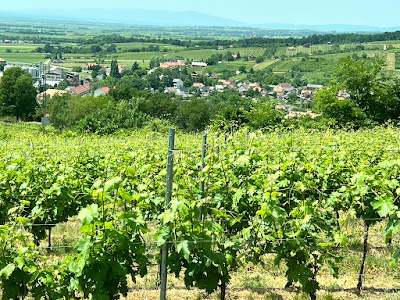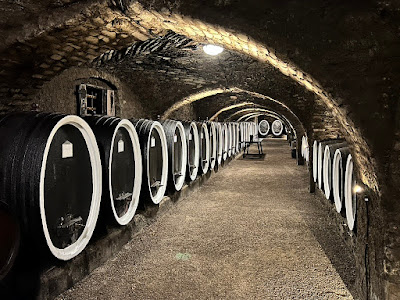During my recent journey to Croatia, as we explored the region of Slavonia, we encountered an intriguing element. Many of the wineries we visited had received subsidies from the European Union (EU), helping to finance their wineries. These wineries are bound by numerous regulations concerning these subsidies, and also have to post a statement about their subsidies throughout the wineries. We saw many of those posts in the wineries we toured. These subsidies could be as much as 1.5 million Euros, and it was impressive to see the EU so willing to assist the wine industry in Croatia.
The first winery we visited in Slavonia was the Kutjevo Winery, which is currently owned by Enver Moralic, who purchased the winery in 2003. Enver, who is originally from Bosnia, is a wealthy businessman, having acquired much of his wealth through oil and chemicals. He owns about 90% of the winery, the other 10% being publicly traded. They export about 40% of their production, and Bosnia is their top export market, likely due to the fact the owner is originally from Bosnia.
The origins of the Kutjevo winery extend back to the 13th century, and it also possesses the oldest wine cellar in Eastern Europe. Cistercian monks, the same order which established wine cellars in Burgundy and the Mosel, came to Slavonia and founded an abbey, called “Vallis Honesta De Gotho,” and wine cellar at Kutjevo in 1232. The abbey lasted for almost 300 years, until it was attacked and destroyed by Turkish invaders. The Kutjevo winery still uses the nearly 800 year old cellar, and we were able to visit it.
Kutjevo is a large winery, producing about 10 million liters of wine (approximately 1 million cases) annually. They own about 430 hectares of vineyards, with another 380 hectares held in a cooperative, and employ about 550 employees. They also own a total of three wineries, two in Croatia and one in Slovenia. Although Kutjevo is not known for red wines, they have been producing some very good ones and they have also been experimenting with amber wines. Although they were once a more traditional winery, they have been engaged in recent years in more experimentation and innovation.
Here is a picture of a map of their vineyards in Slavonia. You can see the diversity of their sites, and the numerous grape types they grow,
We began our tour of Kutjevo by visiting a small tower, located over numerous vineyards, looking out into the Vallis Aurea, the "Golden Valley," which received its name from the ancient Romans. The Romans found this to be an excellent area for vineyards, and Kutjevo is taking advantage of this terror.
While we visited the tower, we also enjoyed some wine, the NV Maximo Brut Cremant, made from Graševina. Kutjevo produced the first sparkling wine in the region, although many wineries now produce it. This wine was crisp and dry, with a creamy mouthfeel, and flavors of apples, a touch of brioche, and some underlying minerality. Very pleasant bubbly!
The Maximo line was inspired by the legend of a passionate love affair from the 18th century. Allegedly, during the early 18th century, the Austro-Hungarian Queen Maria Theresa stopped at the castle of Kutjevo. At this same time, Baron Franz von der Trenck also was present at the castle. Together, they enjoyed numerous bottles of the finest wine, and there was a strong attraction between the two. It's then said that Maria and Franz chose to lock themselves in the wine cellar for a week, drinking wine and making love.
After that week of passion, the two parted and may have never seen each other again. In the cellar, the servants found 70 scratches or notches on one of the walls, which supposedly indicated how many times the two had made love. That would have been basically 10 times a day, quite an incredible feat. The labels of the Maximo line, created for the "passion of love," thus have five "marks", similar to those left behind in the cellar by Maria and Franz.
Once we left the tower, we toured the inside of the winery, and one of the highlights was this huge wine barrel, one of the largest still in use in Croatia. It holds 53,520 liters, the equivalent of about 67,000 bottles of wine! The carvings on the front of the barrel are interesting, showing various aspects of the wine creation process.
This is the entrance to the original wine cellar from 1232, with the date, in Roman numerals, above the doorway.
A couple pics of the inside of the 1232 cellar. Such a fine ambiance, and you can easily imagine yourself back in time, watching the monks working in the cellar.
Within that cellar, we tasted the 2021 Kutjevo Graševina, from their premium collection, which is a best seller for them. They produce about 300,000 bottles of this wine. It was crisp, dry, fresh and tasty, with nice apple favors (which is a typical taste for this grape), and some minerality (due to the volcanic soils where some of the grapes grow). Easy drinking, food friendly, and delicious. During our time in Slavonia, we would taste many expressions of Graševina, and it's definitely a grape that does well in this area.
The Archives cellar contains roughly 65,000 wines, and the oldest is a Pinot Blanc from 1947. We were only able to see the archives from a window past the door, although it would have been fascinating to roam the shelves, seeing what aged wonders we might find.
We then adjourned to a tasting room, to continue sampling a number of their wines. The 2019 Graševina De Gotho, another premium wine, takes its name from the original name of the Cistercian abbey. This wine, made from 100% Graševina and with a 14% ABV, spent some time aging in a barrel, and differed from the previous Graševina we had in the cellar. The De Gotho was rounder and more robust, with apple flavors as well as spice notes. It's the type of wine that can pair well with cured meats.
A slice of Kulen, a delicious, spicy pork sausage with paprika. Some of the best kulen is made from the Black Slavonian Pig. We ate plenty of kulen in Slavonia, and nearly every winery we visited provided us some kulen and cheese for our wine tastings. We also enjoyed it at a number of restaurants. If you visit Slavonia, you definitely need to enjoy kulen.
The 2019 Maximo Oro is a blend of 70% Grasevina and 30% Chardonnany, and some of the Chardonnay spent time in the barrel. With a 14% ABV, it reminded me of the De Gotho, although it wasn't as robust, and the spice notes were more subtle, with brighter apple flavors.
The 2021 Kutjevo Rosé is an intriguing blend of :Pinot Noir and Zweigelt, and this was only the second year they produced this wine. With a 12% ABV, this Rosé reminded me of a Provence Rosé. fresh, crisp and dry with pleasant red fruit flavors of cherry and strawberry.
The 2019 Pinot Crni de Gotho (Pinot Noir), with a medium red color and a 13.5% ABV, was light bodied but with some intensity. It was also elegant, with flavors of almost black cherry, a touch of plum, and a hint of spice. Good acidity, mild tannins, and a lengthy, pleasing finish. We would taste a number of excellent Pinot Noirs in Slavonia, which was unexpected to me.
The 2017 Maximo Nero is a blend of Cabernet Sauvignon, Cabernet Franc, and Merlot, with a 13.5% ABV. With a very dark red color, it was smooth and silky, with restrained tannins, dominant black fruit flavors, mild spice notes and a lingering, satisfying finish. Quite an impressive wine, especially with its lower ABV.
The final wine of our tasting was the impressive 2018 Kutjevo Grasevina Ice Wine, with only a 10.5% ABV. With an alluring aroma of tropical fruit, the wine presented with a complex and intriguing taste of pear, apricot, dried fruit, and honey, with excellent acidity and only a mild sweetness. The finish almost seemed endless, and this would be an excellent dessert wine. Highly recommended.
After the tasting, we were hosted for lunch, beginning the meal with some Plum Rakija. In Slavonia, it is most common to make plum, walnut or pear rakija. There is also an old tradition that when a child is born, some rakija is put aside, sometimes even buried underground, until that child's wedding day. Aged rakija to celebrate a special occasion.
Our delicious lunch there included wild boar (which I loved), polenta, mashed potato, stuffed green peppers and salad.
Dessert included fresh strawberries and cherries.































No comments:
Post a Comment